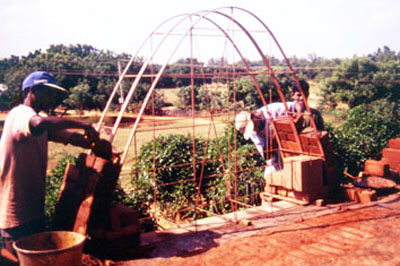Egyptian Vault
The construction of this vault was the first step for the research on the optimisation method for vaults. The aim was to see how to build an Egyptian-shaped vault, with a minimum thickness.
In fact the shape of this vault is slightly different than the Egyptian-shaped vault: it took the shape of a catenary, as the beginning of the vault is slightly flatter than the normal vault. This little difference makes that it was possible to build it with 17.7cm at the third bottom part and 14cm above, instead of the regular thickness which is normally 71.5cm all over the vault, for 5 m span.
In fact the shape of this vault is slightly different than the Egyptian-shaped vault: it took the shape of a catenary, as the beginning of the vault is slightly flatter than the normal vault. This little difference makes that it was possible to build it with 17.7cm at the third bottom part and 14cm above, instead of the regular thickness which is normally 71.5cm all over the vault, for 5 m span.
|
A few years after completion, the vault was extended with a part cantilevering 80 cm outside, so as to protect the window frame and the entrance of the building. It has been built in 12 days with 4 masons and presents these features: • 5 m span, 3.55 m rise, 9 m long, 17.7 & 14 cm thick. • Stabilised earth waterproofing • It has been built free spanning and with vertical courses. |
This vault has been built in 1995 and it welcomes the conference room of the training centre of the Auroville Earth Institute.
The vault has been initially waterproofed with a stabilised earth plaster, composed of 3 coats of various mixes of cement, soil, sand and a paste made of lime, alum and tannin. Note that this kind of waterproofing is still under research and is not disseminated.
The vault has been initially waterproofed with a stabilised earth plaster, composed of 3 coats of various mixes of cement, soil, sand and a paste made of lime, alum and tannin. Note that this kind of waterproofing is still under research and is not disseminated.




















